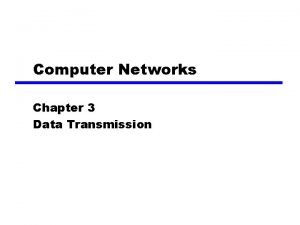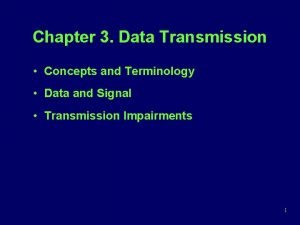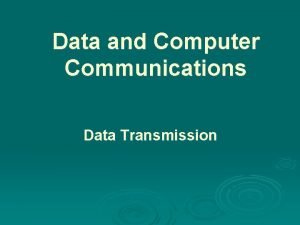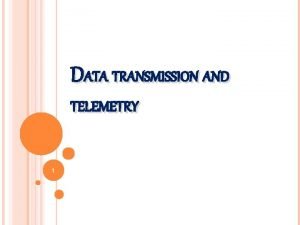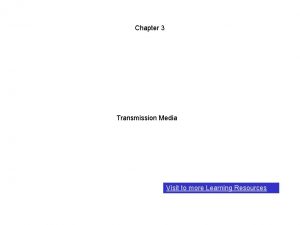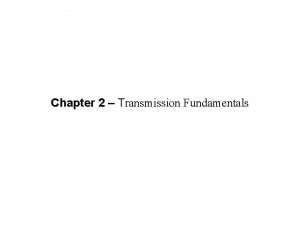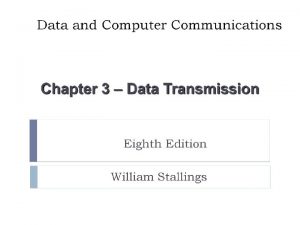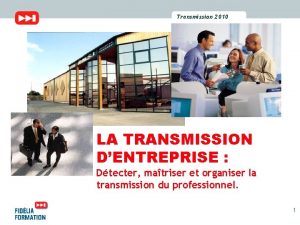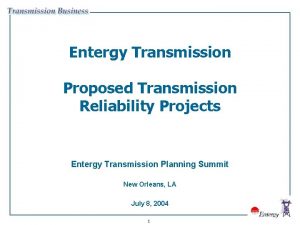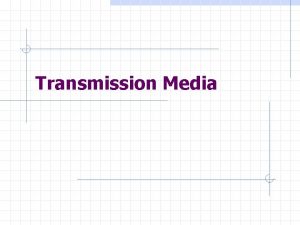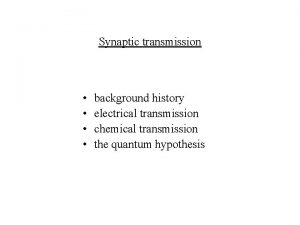Chapter 3 Data Transmission Concepts and Terminology Data














- Slides: 14

Chapter 3. Data Transmission • Concepts and Terminology • Data and Signal • Transmission Impairments 1

Transmission Terminology • Guided and unguided media • Simplex, Half-duplex, Full-duplex tx • Time-Domain representation • Frequency-Domain representation 2

Time Domain Representation 3

Frequency Domain Representation 4

Data Rate vs. Bandwidth • Case A (transmission system bandwidth = 4 MHz) – (4/p)[sin(2 pft) + (1/3)sin(2 p(3 f)t)] 101010… (Treat the waveform as a bit string of 1 s & 0 s) – Bandwidth 4 MHz = 3 f – f = 2 f = 2 MHz – Data rate = 2 f bps = 4 Mbps • Case B (transmission system bandwidth = 4 MHz) – (4/p)[sin(2 pft) + (1/3)sin(2 p(3 f)t)+(1/5)sin(2 p(5 f)t)] – Bandwidth 4 MHz = 5 f – f = 4 f f = 1 MHz – Data rate = 2 f bps = 2 Mbps 5

Data Rate vs. Bandwidth (cont) A T= 1/f B 6

Data and Signals • Analog data – a function of time and occupy a limited frequency spectrum – can be represented by a electromagnetic signal occupying the same spectrum • Digital data – can be represented by digital signals, with a different voltage level for each of the two binary digits 7

Data and Signals (cont) Analog signal Analog data Digital signal Two alternatives: (1) signal occupies the same spectrum as the analog data; (2) analog data are encoded to occupy a different portion of spectrum. Analog data are encoded Digital data are encoded using a modem to produce analog signal. Two alternatives: (1) signal consists of two voltage levels; (2) digital data are encoded to produce a digital signal with desired properties. using a codec to produce a digital bit stream. 8

Treatment of Signals Analog transmission Analog signal Digital signal Is propagated through amplifiers; same treatment whether signal is used to represent analog data or digital data. Not used Digital transmission Assumes that the analog signal represents digital data. Signal is propagated through repeaters. Digital signal represents a stream of 1 s and 0 s, which may represent digital data or may be an encoding of analog data. Signal is propagated through repeaters. 9

Analog Signal 10

Digital Signal Data 11

Transmission Impairments • Attenuation distortion (strength of a signal) – Guided media: logarithmic – Unguided media: complex function of distance and of the makeup of atmosphere. – Increasing function of frequency • Delay distortion (peculiar to guided media) – The velocity of propagation of a signal through a guided medium varies with frequency – Inter-symbol interference • Some of the signal components of one bit position will spill over into other bit positions 12

Transmission Impairments • Noise – Thermal noise (white noise) • Due to thermal agitation of electrons • Function of temperature • Uniformly distributed across the frequency spectrum • Cannot be eliminated, place an upper bound on comm. – Inter-modulation noise • Different frequencies share the same tx medium – Crosstalk • Electrical coupling – Impulse noise 13

Channel Capacity • Nyquist Bandwidth – Case of a channel that is noise free – Given a bandwidth of B, the highest signal rate that can be carried is 2 B – If the signals to be transmitted are binary (2 voltage levels), then the data rate is 2 B bps • Shannon Capacity Formula – C = B log 2 (1+SNR) – Theoretical maximum that can be achieved – Consider white noise only 14
 Data transmission terminology
Data transmission terminology Data transmission concepts and terminology
Data transmission concepts and terminology Transmission terminology
Transmission terminology Terminology and concepts
Terminology and concepts Chapter 19 disease transmission and infection prevention
Chapter 19 disease transmission and infection prevention Chapter 19 disease transmission and infection prevention
Chapter 19 disease transmission and infection prevention Chapter 19 disease transmission and infection prevention
Chapter 19 disease transmission and infection prevention Voltage and current telemetry system
Voltage and current telemetry system Digital data transmission
Digital data transmission Dfd symbols are referenced by using all
Dfd symbols are referenced by using all Dfd chapter 5
Dfd chapter 5 Gib medical abbreviation
Gib medical abbreviation Chapter 15:8 using sterile techniques
Chapter 15:8 using sterile techniques Transmission media in data communication
Transmission media in data communication Automobile data transmission system can bus training stand
Automobile data transmission system can bus training stand
